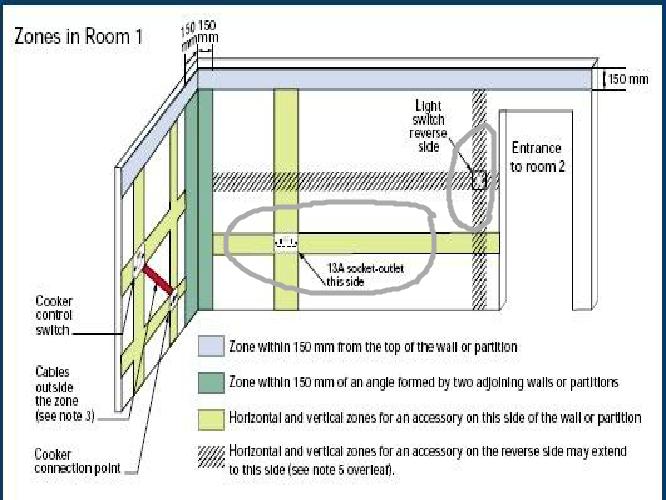D
doingitmeself
I have a very quick question on 'safe' zones. I'm thinking about adding a new socket in our dining room on a wall which currently has no sockets at all. As you will see in the attached diagram, there is an existing socket in the lounge, which is just the other side of the partition wall which separates the dining room and lounge. This socket was installed when the house was built, and is part of the main ring main. The cables feeding this socket go straight up to the ceiling void.
I'm trying to avoid taking off any plaster since we only recently decorated both rooms. As I understand it there is a 'safe' zone which extends horizontally from both sockets (coloured purple in the diagram) which means that I can happily run cables between the two sockets without any form of mechanical protection being required.
The house is entirely dry lined so I'm hoping that I can simply thread a length of 2.5mm through the inch gap between the blocks and the plasterboard and connect up to the sockets at each end. My understanding is that since the cable will be run in a 'safe' zone there is no need for the cable to be run in any form of trunking or metal capping. I've tapped out the route of the cable and am reasonably confident that there are no 'dabs' on the horizontal between the two sockets so it should be a straight run.
Am I correct in my thinking or is there something more involved here? Any suggestions would be gratefully received. Thanks in advance!
http://media.diynot.com/190000_189974_47775_28868289_thumb.jpg
I'm trying to avoid taking off any plaster since we only recently decorated both rooms. As I understand it there is a 'safe' zone which extends horizontally from both sockets (coloured purple in the diagram) which means that I can happily run cables between the two sockets without any form of mechanical protection being required.
The house is entirely dry lined so I'm hoping that I can simply thread a length of 2.5mm through the inch gap between the blocks and the plasterboard and connect up to the sockets at each end. My understanding is that since the cable will be run in a 'safe' zone there is no need for the cable to be run in any form of trunking or metal capping. I've tapped out the route of the cable and am reasonably confident that there are no 'dabs' on the horizontal between the two sockets so it should be a straight run.
Am I correct in my thinking or is there something more involved here? Any suggestions would be gratefully received. Thanks in advance!
http://media.diynot.com/190000_189974_47775_28868289_thumb.jpg


